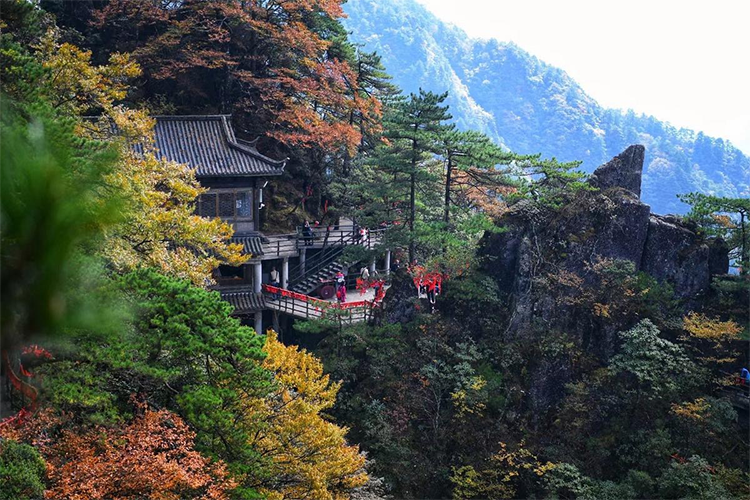Hike into the Cloud Sea at Yangshimu, Mount Wugong
Introduction:
When the first ray of morning light slices through a rolling sea of clouds, the granite pinnacles of Yangshimu rise like sleeping giants from milky mist—an everyday natural epic at 1,600 meters above sea level. This highland sanctuary blends dramatic karst-like rock formations with the ethereal atmosphere of Taoist heritage. Visitors still echo Xu Xiake’s praise of “countless jagged peaks and competing ravines” when they stand before this living landscape.
1. Natural and Timeless Masterpiece: Granite Peak Forest Wonder
Yangshimu’s geological story began with the Yanshan movements 140 million years ago. Mesozoic granite was torn, uplifted and sculpted by wind and weather for eons to form today’s breathtaking stone forest. Needle-like spires pierce the sky—“Cloud-Piercing Pinnacle” seems lifted from another world—while formations nicknamed “Golden Rooster Returning to Nest” create dramatic silhouettes at dusk. These shape-like rocks hide and reveal themselves amid fog: hard and sharp at noon, softened by sunrise and sunset light, making the area a favorite stage for landscape photographers.
2. A Four-Season Alpine Canvas
Vertical relief creates distinct seasonal scenes:
– Spring (April–May): Rhododendrons climb from 1,200 m secondary forest up to meadows, producing a rare three-dimensional sea of flowers.
– Summer (June–August): Cool 20°C conditions turn meadows into a green carpet; the probability of a cloud sea rises to about 70%.
– Autumn (September–November): Thousands of hectares of grassland turn golden, forming Monet-like color blocks against deep fir forests.
– Winter (December–February): Rime coats the rock peaks into crystal sculptures; on clear days visitors may witness the rare “Buddha’s Light” optical phenomenon.
Pro tip:
The “cloud waterfall” is most spectacular between 9:00 and 11:00 in autumn—arrive early to secure the best viewing platform spot.

3. Ancient Paths and Taoist Traces: Hidden Cultural Codes
A Ming-dynasty stone plankway winds along cliffs toward an ancient ritual terrace dating from the Zhengde era. These rugged stone structures avoid ornate carving and instead embody the Daoist principle of “following nature.” Local legends say the Taoist alchemist Ge Hong once gathered herbs and refined elixirs here, and the travel writer Xu Xiake left footprints that modern hikers still follow on the “Xu Xiake Ancient Trail.” The park offers Taoist cultural experiences where visitors can join morning bell and evening drum rites or learn to interpret thunder-magic talismans carved into rock faces with a guide.
4. Outdoor Paradise: From Leisure to Extreme
Hikers can choose among three classic routes:
– Lightweight: Cliffside boardwalk loop (3 hours / 5 km, primarily wooden plankway)
– Challenging: Yangshi Peak Grand Loop (8 hours / 15 km, includes iron chain climbs)
– Pilgrimage: Xu Xiake Ancient Trail traverse (2 days, 1 night, camping on alpine meadows)
Family visitors can ride the newly opened Qingyun Cableway straight to the core area in just 12 minutes. The park also features starry-sky tent camps and highland tea houses to suit different tastes.
5. Practical Guide: Preparing to Cross the Cloud Sea
Transportation:
– High-speed rail to Yichun Station → tourist shuttle bus (1.5 hours direct to Dongjiang entrance)
– Private hire from Pingxiang North Station is more flexible (approx. 200 RMB per car)
Tickets:
– Peak season (April–November): 120 RMB per person (boardwalk included)
– Off-season: 80 RMB per person; cableway one-way 60 RMB
Accommodation:
– Upscale: Muyeno Starry Sky Tents (with floor heating)
– Unique: Wugongshan Taoist cultural homestays
Special reminders:
– Book at least 3 days in advance for the October Golden Week
– Early-morning temperature swings can reach 15°C—bring a windproof jacket
– English audio guides must be rented at the visitor center in advance

Conclusion:
When the city compresses into a blur of lights and the cloud sea erases modern traces, Yangshimu completes a temporal cleansing with its ancient rock teeth and ever-moving mist. This place is not merely a chapter in a geology textbook but a must-have stop on any seeker’s map of China’s mountain spirit. Pack your bag—let 1,600 meters be the threshold for a new way to see the planet.


